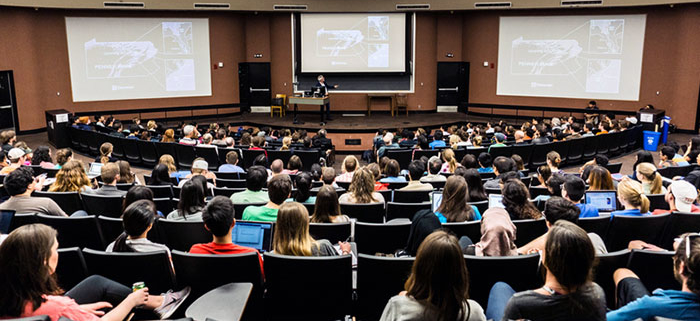Why you need live captions for education
For students with hearing issues, lectures can be more than a challenge.
It’s hard enough trying to hear someone in a crowded lecture hall, but add in other factors like background noise, low-quality microphones, or difficult subject matter, and even those without hearing problems struggle.
Students who speak English as a second or third language often have difficulty understanding what’s going on.
Luckily, there is a simple solution to the problem – live captions for education.
What are live captions?
Captions are simply text on a display screen that explains what is being said during an event.
This is usually a full screen of text but can also be used with lecture capture software, Zoom, MS Teams, or on top of PowerPoint slides or videos.
It’s mainly used for dialogue, but can also describe noises, music, and emotional changes in a person’s speech.
Live captions are exactly what they sound like – normal captions but the event is live, not pre-recorded.
This means someone listens to what’s going on, and then types it out at an incredibly fast pace with high accuracy.
Why institutions should use live captions for education
The most important reason academic institutions should use live captions is to offer educational access to everyone.
In the UK, under the Equality Act of 2010, all Universities and Higher Education Institutions must make “reasonable adjustments” to accommodate those with disabilities.
Students must not be discriminated against in any way which hinders them from receiving education, access to a benefit, facility, or service, or by excluding them in any way.
Why students should use live captions
Obviously, those suffering from hearing loss would benefit the most from live captions, but all students should consider it.
Captions clarify dialogue when the speaker has an accent, mumbles, or speaks too quietly.
For the thousands of students who speak English as a second language, live captioning for education is the perfect way to keep on top of things, helping them to fully understand what’s going on, especially when it comes to technical subjects.
Captions also improve test scores, helping students to focus and remember more effectively. In fact, one study found that reading comprehension increased dramatically when captions were used compared to uncaptioned educational videos.
We understand live captions for education
Here at 121 Captions, we know and understand the demands of being a higher education student.
Many in our team are higher education career consultants, working regularly with universities to deliver exceptional, high-quality live captioning.
Our speech-to-text reporters (STTR) can caption word for word at up to 360 words per minute, with only a one second lag time!
This allows students to read the lecture, word by word, at the same speed as their peers hear it, enabling them to answer questions, participate in discussions, and make comments, levelling the playing field for everyone.
All our speech-to-text reporters are registered and accredited by internationally-recognised professional associations, all of which have high qualification requirements and abide by their professional codes of conduct.
The system is simple yet effective, and with a network of over 300 captioners all over the world, we can provide a captioner at short notice and easily accommodate changes to scheduled teaching.
Contact us today if you would like to know more about live captions for education.
Our friendly and professional staff will be happy to help in any way they can.




Leave a Reply
Want to join the discussion?Feel free to contribute!